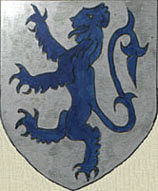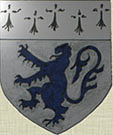WHERE DOES SKELTON'S POO GO ?
When we pull the bath plug or flush the toilet all the liquids and solids pass through the house and street drains, no wider than 6 inches, before reaching the main wider drains that eventually travel underground roughly the same route as Saltburn Lane.
Beneath Cat Nab, Saltburn is a pumping house where the whole waste of Skelton and nearby villages is forced at high pressure up a pipe no wider than one foot.
From there it travels to Bran Sands on the banks of the river Tees, where in the Northumbrian Water Company treatment plant it is converted to clean water and fertiliser.
Not a drop is wasted in a complex process, during which poo is eaten by microbes, usable gas is created and electricity generated to power the plant itself.
|

Bran Sands, Teesport, Water Treatment Plant, commissioned 2009.
|
|
The following Northumbrian Water video describes the same process at their treatment plant at Howdon, Co Durham.
|
Compared to the old days this modern cleansing process is nothing short of a miracle.
Just 60 to 70 years ago some Skeltoners were still defecating through a hole in a wooden board into a metal bin.
60 to 70 years before that there were many deaths, particularly of children, because no proper sanitation existed.
Before the 1850s the Industrial Revolution had seen the growth of large towns and cities.
The medical profession had no idea that many diseases were caused by people living in crowded conditions of squalor and drinking the contaminated water that often resulted.
There were many outbreaks of Cholera in which many deaths occurred. The new town of Middlesbrough did not escape.
As the previous webpage shows Skelton up to the 1860s was a comparitively clean, small agricultural village with water supplied by a pure spring and isolated farms dotted around a widespread Parish.
But the discovery of Ironstone, the consequent population growth, the building of closely packed terrace houses and the greater use of Well water caused similar unsanitary conditions and related diseases here.
There was much personal ignorance. People lived with there own muck and refuse, without realising the dangers to health.
In 1854 during a cholera epidemic a London doctor, John Snow, discovered the cause was contaminated water from a particular pump and the next decades saw a nationwide surge in providing clean water and
sewerage clearance.
In London so much muck was poured into the Thames that in 1858 they had the 'great stink' that even affected MPs in Parliament and action was finally taken.
Seven years later Bazalgette's sewerage system was opened that took the waste out to sea.
However, it was a long time before areas outside of London had similar sewerage systems. Installing miles of pipes needed a large investment of money and local ratepayers were reluctant to pay.
Provision of clean water took precedence because there was money to be made selling it and the Cleveland Water Company was established in 1870.
Efficient sewerage systems were eventually forced upon local authorities by Acts of Parliament and in Skelton's case a lawsuit in the Courts.
The following extracts from local newspapers give some indication of local conditions and how sanitation came to Skelton.
1870.
16th August -
NUISANCE AT SKELTON CLAIMED - PRIVIES LEAKING.
Letter to Editor.
I refer to the state of Taylor's Buildings, which are a disgrace to any village boasting a Board of Health, a Surveyor and an Inspector of Nuisances.
No proper road to 20 houses, insufficient water supply, from all the privies in the back row there exudes through the wall a stream of filth running into the street.
I am informed that these buildings belong to a member of the Board of Health.
Ratepayer.
29th August. -
SKELTON NUISANCES HIGHLY EXAGGERATED.
Letter to Editor.
Sir, - My attention was directed to a letter in the [Daily Gazette, Middlesbrough] of Tuesday the 16th, referring to the sanitary condition of Skelton, but more especially to those tenements which your correspondent terms "Taylor's Buildings", but are properly called Prospect Place and Milbank-terrace.
When men have little or no regard for truth in their letter-writing, they generally keep back their proper name; so with your "Ratepayer" in this case.
As regards the complaint No 1 respecting proper roads, I beg to say there are three roads and one of them which is the foot road only, is now being made wider, and until finished, will be a little inconvenient for all Ramblers.
Complaint No 2 refers to an insufficient supply of Water.
This is absolutely untruthful, there being a spring of pure good water in front of each terrace and only about 20 yards away from the buildings.
As to charge No 3, the Inspector very closely examined the yards, ashpits and privies when the letter made its appearance and found only two ashpits a little out of order in all the twenty cottages.
This Ratepayer's allegations will not affect very seriously the respectability of the Skelton Local Board of Health, or the Surveyor, nor yet the "Inspector of Nuisances", when I state that although on an average not less than 150 adults and children occupy these cottages, there has not been more than two deaths during the five years they have been built.
There cannot, therefore, have been much "disease" or otherwise the "parish doctor" has been remarkably skilful.
Perhaps this Ratepayer, when he takes another ramble and wishes to trouble the public with sketches of his travels, will, for "decency's" sake be truthful and not ashamed of his name and profession.
I am yours &c.
Thomas Taylor.
[Skelton Shopkeeper and member of Skelton Local Board.]
1873.
8th October - DRAINAGE OF SKELTON.
Skelton Local Board met with Mr J T Wharton in the chair and D T Petch, W Gowland, N Stonehouse, J Leng, S Emmerson, J Tyreman and M Marley present.
The tender of £195 for the drainage of Skelton was accepted.
[Details of this work are not presently known, but for this amount you would think it was not extensive, as future schemes involved taking out a Government loan of thousands.]
Messrs Bell Bros were instructed to cover the ashpits of their houses in Park Street or the Board would do the work and charge them.
|
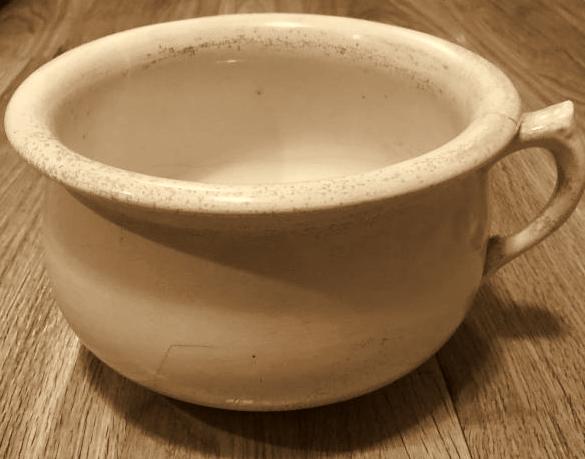
Chamber Pot.
|
1874.
THE PEE POT.
At a Mines inquiry this year into the safe storage of gunpowder it was stated that some Miners kept open casks of gunpowder under their beds.
Virtually all beds would have had a smelly, but slightly less hazardous container - some kind of vessel for a 'wee' in the night.
Otherwise it meant a cold walk to the outside 'dry toilet' at the end of the back yard or in some cases across the back street.
The pee pot remained in use in most houses right up to the late 1900s, when the installation of indoor flush toilets was completed.
7th October -
NEGLECTED PRIVIES.
At the meeting of the Skelton Local Board there was a complaint about the dangerous state of the well on the Cross Green by Messrs Taylor and Son, who had a drapers shop close by.
Fever had broken out in Robinson St and Dixon St where the drainage was unsatisfactory and the privies in a neglected state.
Also a nuisance arose from the urinal of the Duke William Inn.
|
6th December.
THE CAUSES OF FEVER AND REMEDIES.
The Committee appointed to consider the report of Dr Thorn on the unsatisfactory sanitary condition of the district and the best measures to be adopted to remedy the evils complained of recommended that where necessary - after careful examination by the Surveyor - glazed pipes be substituted for the common pipes now in use and connected with the main drainage of the district;
that the existing manholes be ventilated by gratings in lieu of close covers and that other ventilators, at the discretion of the Surveyor, be put into the main drains connected with the street grates, which would also serve for additional receivers of flood waters off the highways.
They also recommended that, where practicable, the down-comers from the roof of any house should be connected with the drain in that yard, so as to form another ventilator discharging at a high level any noxious gas therein.
In many instances the drain in the yard is connected with the sink in the back kitchen of cottages and such connection should be discontinued and the pipe from the sink have an open outlet in the yard over a grating, which would prevent noxious gases getting into the dwelling house.
As to excrement disposal etc the committee recommended that where possible the existing middens should be improved by raising the floors 6 inches above the level of the back streets and coating the middens internally with Portland cement 3 feet high, as well as over the bottom;
Where new privies are required, the pan closet, or the sanitary pipe closet was advised.
The cleansing more frequently and effectively of the ashpits required immediate attention for the improvement in the health of the inhabitants;
that might be done by contracting with a scavenger free of cost to the Local Board - under penalties for inefficient work - weekly or fortnightly or it may be taken in hand by the Board employing a scavenger, with horse and cart, to deposit the refuse in certain localities.
The sale by auction periodically of the accumulation would repay the cost.
1875.
6th July.
SANITARY CONDITION OF SKELTON - DONKEY IN SCULLERY.
The monthly meeting of the Skelton Board of Health was held on Friday evening. Mr E Hamilton presiding.
The dwelling of a man named Thompson, which was said to be owned by a person named Carter, was reported by the Medical Officer, Mr M'Cutcheon, to be in such a condition that he would not live in it 24 hours.
Attention was called to the filthy state of one part of North Skelton and Ricey Hills, arising from bad drainage.
At the latter place there was a long row of cottages and owners, Messrs J M Pearson and Christopher Jackson, having failed to take their drain to a main sewer, the drain was allowed to empty itself into a channel by the side of the highway and an abominable nuisance was thus created.
After a short discussion it was decided to take proceedings against Messrs Pearson and Jackson under the Nuisance Removal Act, if they declined to take steps to abate the nuisance.
An old man, named Jesse Gilmour, who had given the Board a considerable amount of trouble by keeping his donkey in the scullery at Skelton Green, to the great annoyance of some of his neighbours, was again the subject of a brief but interesting discussion.
The Chairman said that, although they did not wish to be harsh with the old man, they must have their bye-laws respected.
It was then resolved that, if the donkey was not removed to suitable quarters before the next meeting, he [Jesse, not the donkey] should be summoned before the Magistrates.
Several persons having infringed the bye-laws by building sculleries in their yards without submitting plans to the Board. They were ordered to be pulled down.
August.
PUBLIC HEALTH ACT.
A Public Health Act was passed to combat filthy living conditions and the diseases that resulted.
Among many stipulations new houses had to have running water and proper sewerage drainage.
Household waste had to kept in a movable receptacle which the local authorities were charged with emptying weekly.
The Act provided local authorities with new powers, among which were:
to purchase, repair or create sewers.
to control water-supplies.
5th December -
DEATHS FROM FEVER.
The district which embraces the important villages of Skelton, North Skelton, Boosbeck and Lingdale seems unable to rid itself of its fever epidemic.
At the meeting of the Skelton Board of Health on Friday evening the following letter on the subject from Dr S McCutcheon, the Medical Officer of the Board was read:-
Gentlemen - I have to report that Scarlet Fever is still very prevalent in this district.
The disease is not confined to any particular locality.
There is scarcely a street in either Skelton, Boosbeck or Lingdale quite free.
We had seven deaths from this cause alone during the month of November.
I am glad to say that this disease is now assuming a milder type and that we have not had a fatal case since November 25th.
As to isolating the infected cases and preventing the spread of the disease, I can only say that any efforts I have made have proved almost futile.
It is altogether impossible, in my opinion, to prevent people visiting their sick neighbours and friends and thus carrying the germs of the disease from house to house.
My observations on scarlet fever as to locality might be repeated with regard to enteric fever.
There is scarcely a street in all my district where enteric fever has not occurred within the last 3 years.
I may just state that I have at present one or more cases in the following streets - High St, Green Rd, Park St, Boosbeck Rd, Harker St, Cleveland St, Fenton St, North Tce, Scarth St, and
Dixon St [Lingdale], in all about 15 cases.
I only had one death from this fever during the present outbreak.
|
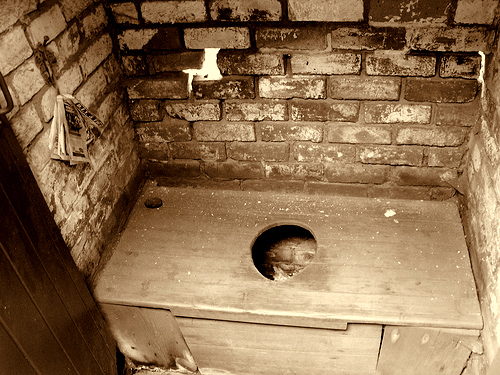
Outdoor dry toilet.
|
1876.
8th March -
BAD DRAINS, FEVER.
A considerable time was occupied by the Local Board in discussing matters connected with the drains on Mr Ritson's property on the Green, Mr R Ditchburns at Boosbeck and in Robinson Street, belonging to various owners.
Mr D T Petch remarked that fever was very prevalent on the latter property.
The Surveyor was ordered to make the drains according to the plans and charge the cost to the owners.
1879.
An Act of Parliament included Moorsholm-cum-Gerrick and Stanghow in the Skelton Local Government District.
The Skelton Sanitary Authority combined with those of Guisborough, Loftus and Brotton into a Board of Public Health and a Dr Keith of Kirkleatham was appointed as Medical Officer.
This dealt with matters like pollution of water supplies, insanitary accommodation, epidemics etc.
1881.
3rd June -
WELL WATER NOT SAFE.
|
The Medical Officer reported to the local board that Well Number 20 on Boosbeck Rd, Skelton Green had water that was turbid and had an unpleasant smell.
The total solids were in excess and the albuminoid ammonia more than should exist in a passable water.
It was undoubtedly subject to sewage contamination and unsafe. Orders were made for its closure.
30th July -
STREET IMPROVEMENTS AND SEWERAGE ON TICK FOR 10 YEARS.
Major Tulloch, a Local Government Board Inspector, held an inquiry at Skelton yesterday with respect to the application of the Local Board of Health for sanction to borrow £1,500 for works of sewerage and £3,300 for works of general street improvements.
Mr E Hamilton asked to allow the Board to repay the loan over a space of 10 years.
[It seems likely that this sewerage system discharged into local streams, as in following years Saltburn Council complained of the pollution of Skelton Beck and in 1894 took Skelton and Brotton Council to Court, compelling them to borrow the money required to install a sewerage system direct to the North Sea.]
1882.
25th October -
DANGEROUS WELL IN NEW SKELTON.
Thomas Taylor, a Grocer in an extensive way of business at Skelton, was summoned by the Skelton Local Board to show cause why he should not close a Well on his properties.
Several cases of fever had recently occurred at Skelton and caused considerable alarm.
Dr Stainthorpe, the medical officer, had inquired into the outbreak and on analysing the water in Taylor's Well he found it was pregnant with matter which would tend to the spread of disease.
Private drains soaked into the well and the water was not fit for domestic use. The Bench ordered its closure.
1883.
1st June -
FEVER.
Medical Officer, Dr Stainthorpe, reported a case of Scarlet Fever in Charlotte St, New Skelton and a case of enteric fever in Skelton.
He recommended flushing the whole of the drains with a solution of carbolic acid to be done at once and defective drains to be remedied.
1885.
POLLUTION OF SKELTON BECK.
The question of the pollution of Saltburn Beck again came up for consideration.
The Clerk was instructed to inform the Saltburn Local Board that the Skelton and Brotton Board do not admit any liability on their part, to keep the course of the beck at Saltburn open and to ascertain who is responsible for the formation of an artificial lake or pool at Saltburn which prevents the free course of the water at the point named.
1890.
7th June -
NEW FOOTPATHS AND SEWER.
The meeting of the Skelton and Brotton Board resolved to make a footpath, kerbed and channelled, in front of the Skelton Green Infant School at a cost of £13 3s 4d.
Also a footpath at a proportionate cost from the Miners' Arms to the end of Trout Hall Lane;
also a flushing tank and sewer at Skelton Green at a cost of £14 10s.
1894.
2nd May -
POLLUTION OF SKELTON BECK.
At a special meeting of the Stockton County Court, Dr Lennard on behalf of the Saltburn Local Board made application to his Honour Judge Turner for an injunction under the River Pollution Prevention Act 1876 to restrict the Skelton and Brotton Local Board from continuing the pollution of the Skelton beck by permitting sewage matter to flow into it.
Mr J Scott Fox appeared for the Skelton board and admitted they were polluting the stream in question.....but were prepared to adopt a scheme for the abatement of the nuisance complained of.....
Plans for a comprehensive drainage scheme had been prepared under which the sewage matter would not be carried along the course of the beck at all but to a point known as the Crane lane Spout.
From there it would be carried by a boring through the cliff to a point below the low water mark.
1895.
19th August -
SEWAGE DISPOSAL ON TICK.
The Finance Committee of the Skelton and Brotton Urban Council met on Friday to consider the question of borrowing money to carry on the sewage disposal works now in progress to carry the district's waste out to sea.
They decided to borrow £15,000 to be repaid in 20 annual instalments.
The Clerk intimated that he had numerous offers from persons willing to advance the money.
2nd November -
RAILWAY TRUCKS FULL OF NIGHT SOIL.
At the monthly meeting of the Skelton and Brotton Urban District Council a letter from the Manager of the North Eastern Railway Company was read, saying that he had given instructions that the trucks of nightsoil should be unloaded at once and at an early hour of the day.
1896.
10th August.
SEWERAGE SYSTEM TO THE SEA NEARLY COMPLETE.
At the monthly meeting of the Skelton and Brotton District Council, Mr Balfour, Civil Engineer, reported that the new sewer and sewage outfall works were completed with the exception of a few minor details along the line of pipes.
The subsidence near the halfway house has been made good and the whole of the drains in the Councils district connected with the mains.
The sewage is now turned on and has been running through the pipes about a fortnight and the streams are no longer being polluted.
The contractor, Mr Carrick, was making compensation to owners of land and gardens for damage done to crops etc.
1897.
15th March -
SEWER TO THE SEA.
The Skelton and Brotton sewerage scheme, for which a loan of £15,000 was obtained, was at the last meeting of the Skelton and Brotton Council reported to be completed.
Owing to the pollution of the Skelton beck which runs through the Saltburn Pleasure Gardens an injunction was obtained.
After a Government enquiry, the services of Mr D Balfour of Newcastle were called in and under his direction about 10 miles of pipes have been laid.
Many difficulties had to be overcome, but is is safisfactory to know that the sewage which runs out to sea will be carried away even at low tide.
Local people would have to continue using dry toilets, however, for another half century and these pipes must have been initially only for the street drains and kitchen waste.
|
 The Sewer pipe can be seen clearly on this photograph on the Left before disappearing into the sand.
The Sewer pipe can be seen clearly on this photograph on the Left before disappearing into the sand.
Pouring sewerage into the sea made the water unfit for bathing and seafood unfit for consumption, but it was some time before this was realised.
All the land and beach on this side of Skelton Beck was part of Skelton until it was transferred to Saltburn Council in 1934.
|
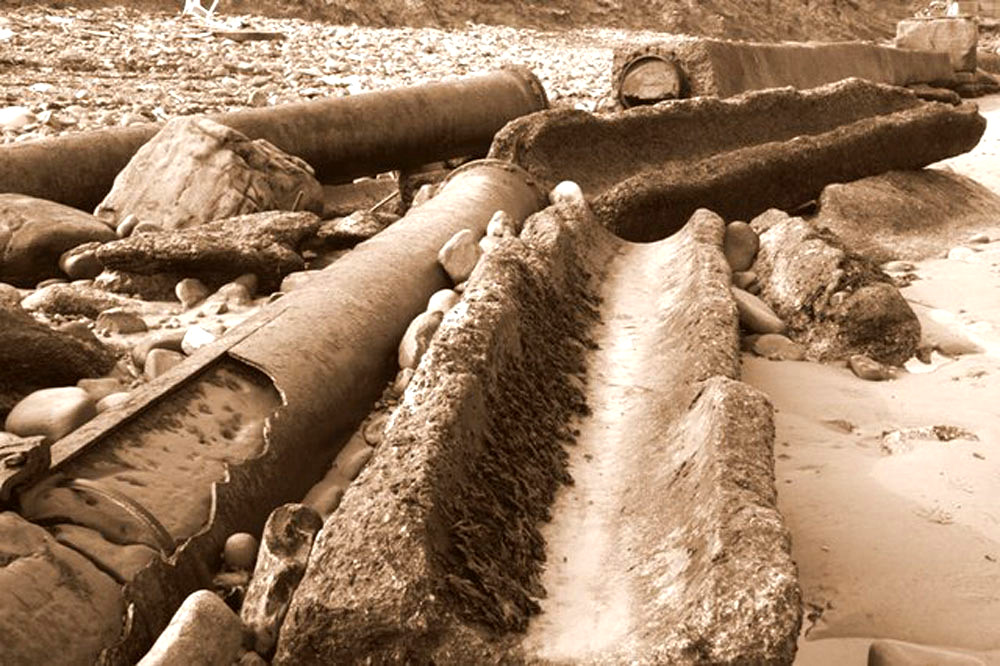 The old Sewer pipe, filled with concrete at some time, withstood the pounding of the tides until well after the Second World War.
The old Sewer pipe, filled with concrete at some time, withstood the pounding of the tides until well after the Second World War.
|
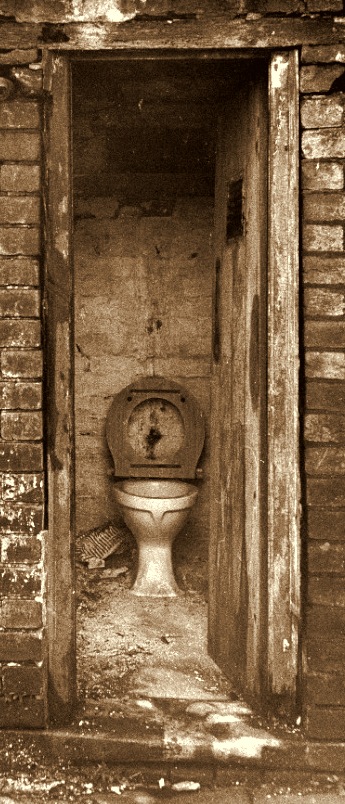
Outside Flush Toilet.
|
OUTSIDE TOILETS.
To defecate, urinate and get rid of ashes from the coal fire and much other trash local people visited the "lav" or "netty".
It was usually at the end of a back yard, next door to a coal house.
In some cases, like Robinson St, Skelton, it was necessary to cross the back street.
A smooth, wooden board with a round hole for the buttocks in an unlit, unheated brick box.
A cold place on a winter's morn and infested by bluebottles, spiders and all manner of insect life on a summer's one.
And wipe your backside on any publication that you could get hold of, with a few careful tearings by the seat.
Was the Empire News or Daily Herald "softer" than the local Daily Gazette ?
Beneath the board droppings were deposited in a metal bin.
This photograph below of the back of Park Street, Skelton [now demolished] shows areas of wall that have been bricked up.
The lower ones were where, when these houses were built, wooden lift-up doors used to be.
This was where the bin was removed for emptying by workers, politely called the 'night soil men'.
At first the Council contracted the work out and it was done by horse and cart.
Apart from the introduction of the internal combustion engine to propel the cart, the true origin of the old joke - what has six wheels and flies, such were the local defecation facilities for most ordinary folk until the mid 1900s saw the introduction of flush lavatories.
I can remember the men myself in the 1940/50s, dressed in leather aprons.
The bins at that time were a metal box, around 2 by 3 feet and 2 high, with handles at the ends.
Full of human waste and wet ash from the coal fires they must have been stinking, weighty objects to lift and empty into the back of a truck, which had rounded sliding lids.
I have never discovered where the muck was taken to.
This was progress, as previously toilets were just holes in the ground - middens.
When the first flush toilets were installed there was no improvement in the cobweb decor, as they just replaced the dry toilets in the same outside buildings.
It was late in the 1900s before most terrace houses had modern kitchens, bathrooms and indoor toilets installed.
|

|

|
1917.
25th January -
NIGHT SOIL - CO-OP MEN ON COUNCIL ARE HYPOCRITES.
Mr Stephen Emmerson of Holly Bush Farm, Skelton writes:-
I notice that at a meeting of the Skelton and Brotton Council, held at North Skelton on Friday, January 3rd, 1917, Mr A R Cranmer reported that he had interviewed certain farmers in the Skelton district for the removal of night soil from Park Street, Skelton and Mr K Ross was prepared to do the same for £36 for one year.
The price paid last year was £24. The Chairman remarked that he objected to the tender, as it was nothing less than extortion and he thought the farmers had an idea that they had the Council in their power.
I, as a Skelton farmer, strongly object to this report.
Mr K Ross informs me that he never tendered for the scavenging and did not intend to do any on account of shortage of labour and danger to his horses, including mares in foal.
I may say Park Street includes other five streets, two of them making it impossible for horses to remove night soil - these streets are paved with slag bricks.
Seeing that the Co-operative farm has taken over Boosbeck district for £50 [pre war tender being £25] I think that it is a gross injustice to us farmers to be singled out as extortioners.
Also please note that there are several Co-operative Committee men on the Urban Council and there was no comment on the 100 percent rise on pre-War price to the Co-operative farmers.
3rd February -
NIGHT SOIL.
Mr K Ross, Green Farm, Skelton, writes:-
Respecting the letters which have appeared in your valuable paper with
|
regard to the removing of night soil from Park Street, Skelton, my name has been referred to in connection with the tenders.
Therefore, I wish the general public to know, in fairness to myself, that I never tendered for 1917, and if the tender form can be produced, I will pay over to the Red Cross, £50.
|
NO END TO SQUALOR.
People, like myself, who have lived through this remarkable transformation in water supply, sanitation and the countless other improvements to the quality of life find it impossible to understand those who take it all for granted and even abuse it.
It seems some folk still want to live in squalor and deliberately spoil things for everyone else.
To see our streets covered in modern litter and dangerous dog muck and even our great countryside used as a dumping ground for household waste seems to me like throwing the good works of our ancestors back in their faces.
The problems of the past have, in many cases, been caused by over population and often by an ignorant, dirty element with no sense of communal responsibility.
But controlling that is a region where politicians of all colours appear terrified to venture.
|
|
